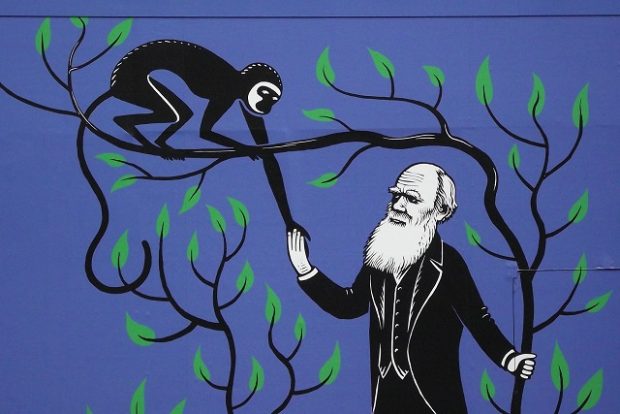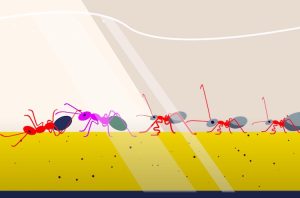Fire ants conquer the world on the first global tr...
New study describes genealogy and spreading of one of the most damaging species of pest ants
The fact that biological shapes could be connected by genetic transformations to each other to D’Arcy Thompson a hundred years ago meant that they were generated by a very orderly process that followed very specific physical, chemical and biological principles. He called these principles the internal forces that generated biological shapes ‘laws of growth’ or ‘law of growth’. Today, by laws of growth, we mean the entire panoply of various developmental processes all the way from gene sequences and gene encoding, which are important for development, various developmental pathways, molecules which are important for cell signalling, the cell differentiation, cell proliferation processes, all the way to how the cells are assembled into tissues, how the tissues are assembled into organs and how from organs you put together a very complex multicellular organism.
This debate, curiously enough, is still very much enforced today and still has not been settled. Why? Because for most species of animals and plants that you see around the world, adaptive explanations are perfectly fine; that is, evolution by itself is a fundamental process that generates diversity. However, the exact mechanisms are still being investigated.
Again, for most species adaptive evolution, natural selection or sexual selection in some examples is enough to explain their origins; however, there are examples, I would argue, where diversity is so great or is so complicated that it cannot be easily explained by environmental factors, that is by natural selection forces alone.
In our work, we focus on some key examples of a process which is called ‘adaptive radiation’. So, what is adaptive radiation? Adaptive radiation is a term first formulated by George Gaylord Simpson back in the 1950s. Simply put, this is the process by which a single ancestor, a single species, gives rise in a very rapid succession to a number of descendants which are morphologically or otherwise diverse. The main reason why they’re diverse and why they evolve so quickly is that they face some kind of available niches: it could be, for example, new islands or new ecological niches, new opportunities which generate a selection for new forms, new shapes. This is how adaptive radiation is produced by an ancestor, which finds itself in a new space, a new ecological or geographical space and then very quickly multiplies.
Adaptive radiation implies two processes: one is increased number of species, what we call species richness which, again, greatly is increased during adaptive radiation, and another one is very rapid changes in morphological diversification, that is these descendants look different from each other and they look different from the ancestor.
This morphological diversification, coupled with species richness, are the fundamental processes which explain adaptive radiations.
One of the key examples of adaptive radiation is Darwin’s finches, which live in the Galapagos Islands and were instrumental to many scientists. In fact, Darwin mentioned them in his Voyage of the Beagle, and he discussed them at length in this early book in 1839. In fact, in this book, he calls them ‘the most singular group of all the animals in the archipelago’, meaning Galapagos Islands, and he was absolutely right because Darwin’s finches are, interestingly, very different from any other species of birds which you find in Galapagos. If you open a modern textbook, Darwin’s finches are an example of adaptive radiation. The main explanation for the diversity is that their ancestor arrived in the Galapagos Islands, and in the absence of competition and in the presence of all the ecological resources, all the opportunities essentially were enough for this ancestor to produce very diverse and numerous descendants.

The problem with this explanation is that the Galapagos Islands were invaded multiple times: in fact, there were 18 independent invasions of the Galapagos Islands from the mainland. There were many other different species of land-birds such as hawks, owls, warblers, flycatchers, doves and many others which came to the Galapagos Islands. Only one of them gave rise to a very highly diverse group, which we now know as Darwin’s finches. In fact, out of the 28 endemic species and 6 subspecies, most of them are Darwin’s finches on the Galapagos Islands.
So, in many ways, even on these Islands, their diversity is very much exceptional. The only other group which is comparable in any way in terms of the number of species is Galapagos mockingbirds: there are four species of Galapagos mockingbirds which evolved on the main islands of Galapagos, but all of them look very similar to each other. They’re slightly different; they’re different enough in terms of their plumage and pigmentation patterns that one can distinguish them. Darwin, in fact, noticed that as well: he used Galapagos mockingbirds in his writing on speciation as well. In fact, Galapagos mockingbirds are an example of what we call ‘allopatric speciation’.
Allopatric speciation is when ancestors arrive to particular space, they find themselves in geographic isolation, and spending enough time in this isolation, they evolved gradually into different-looking species.
In fact, this is how most species of birds evolved around the world. If you go to islands between Asia and Australia, for example, there are hundreds of islands with lots of species of birds: most species of birds evolved via this allopatric speciation, that is, you have slightly different species, usually one per island, which are slightly different from the species the next island. That’s how much mockingbirds evolved on the Galapagos. This is not how Darwin’s finches evolved because we find multiple species for each island, which are very morphologically different from each other.
So we have a situation where a group of birds is evolving with levels of morphological diversity which are unparalleled; these are truly exceptional birds. Darwin was absolutely right; they are the most singular group of land birds on the Galapagos, and they still demand an explanation.
We need to understand why these other species of birds, which arrived to Galapagos Islands, which faced the same opportunities for about the same amount of time, have not been able to become very diverse.
Of course, another question is what allowed Darwin’s finches to become very, very diverse. Our explanation is that during evolution, Darwin’s finches in their ancestral line evolved a novel developmental genetic program that essentially allowed them to become diverse. It’s related to a concept called evolvability: the ability of a species or clade to produce variation. We would argue that genetically different species are different from each other, and some of them, in particular ways, are much more flexible, so to speak, that is, they’re able to produce morphological variation, they’re able to produce variation much more rapidly and much more readily than other species living in the same environment.
Our study suggests that it is important to pay more attention to the laws of growth. Simple adaptation explanations may work really well for most species but perhaps not for all of them. In the exceptionally diverse groups of species such as Darwin’s finches, Hawaiian honeycreepers, Madagascar bangers or phyllostomid bats, African Cichlid fishes, and there are many other examples of exceptional adaptive evolution, we have to look more closely at the genetic mechanisms which generate the diversity to understand the interplay between environmental forces.
We do believe the adaptation environmental conditions and availability of the new resources is indeed important, probably required part of adaptive radiation but likely not sufficient. We need to combine the genetic forces, the laws of growth, the innovations at the development genetic level with natural selection to explain adaptive radiation that we observe in nature.
So we have to look at these stories from this perspective, from both genetic and environmental perspectives.
It is clear that understanding genetic principles of development is quite important for understanding the origins of diversity in the living world. It is clear that in order to produce a new shape, a new biological shape, you have to change something at the genetic level; you have to change something about the developmental program. But are we prepared to think? Are we prepared to accept that, at least in some cases, the innovation at the genetic level is the driving force for producing dramatic biological variation in examples such as Darwin’s finches and Hawaiian honeycreepers?

New study describes genealogy and spreading of one of the most damaging species of pest ants

The male offspring of calorie restricted fathers display reduced anxiety-like behavior as adults

Bioinformatician Manja Marz on assembling DNA reads, high-throughput sequencing, and reverse transcription